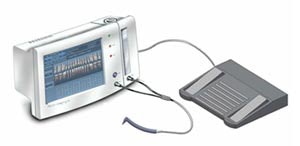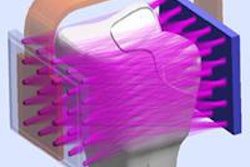
Ultrasound has been used in dentistry for years in clinical applications ranging from power scaling to root canal preparation. But while ultrasound has long been a standard diagnostic tool in other medical disciplines, it has yet to play the same role in dentistry.
In fact, although dental ultrasonography has been studied for more than 40 years, most methods are still not ready for routine clinical use, according to Mark Hinders, Ph.D., chair of the applied science department at the College of William & Mary and co-author of an article on the modality in dentistry (IEEE Transactions on Ultrasonics, Ferroelectrics, and Frequency Control, June 2008, Vol. 55:6, pp. 1256-1263).
"Ultrasound imaging would be too expensive for the dental office, and dental anatomy is in many ways too complex to use ultrasound the way it is used in other parts of the body," he told DrBicuspid.com. "The way diagnostic ultrasound is likely to be implemented in the dental office is different than the way it is used elsewhere."
But Barry Berman, president of Perio-Imaging -- a young company that recently announced a merger with Lantis Laser, another start-up developing advanced imaging systems for dentistry -- disagrees. He believes his company's noninvasive ultrasonic periodontal screening system, the Perio-Imager, is only about a year away from commercial availability.
"We currently have five working prototypes, and our next step is to work with a medical school that is going to provide us with cadaver heads to do some clinical testing," he said. "This will allow us to not only tweak the algorithm we use, but to make certain claims about how much more accurate our technology is compared to manual probing."
More accurate, less invasive
Both men do agree that ultrasonography has the potential to play a significant diagnostic role in dentistry. It is potentially more accurate than manual probing, entirely noninvasive, and does not expose the patient to radiation.
Manual probing is often uncomfortable and has several inherent drawbacks, including variations in examiner pressure, placement, angulation, visual interpretation and recording, and differences in probe tip diameter and individual tissue health, all of which can contribute to inconsistencies in periodontal assessment, according to Hinders (Dimensions of Dental Hygiene, April 2006, Vol. 4:4, pp. 16-18).
“It seems clear that ultrasonography is coming to the dental office some time soon.”
— Mark Hinders, Ph.D., College of
William & Mary
"There are a bunch of reasons why manual probing is not accurate," Berman said. "The patient squirms, the dentist/hygienist can't see below the gum line so they can't see how far down the probe is actually going, the tissue may be inflamed. ... It is misleading if the probe touches something that is inflamed because it is not truly indicative of the pocket depth."
And because ultrasonography is noninvasive, patients are less likely to squirm during assessment or experience any discomfort, he added.
"The probe is placed at the gingival margin and pressed against it slightly," Hinders said. "Only the ultrasound beam goes into the tissues, so it is entirely noninvasive. It is a point-by-point measurement, but since it's painless, there is no reason to not walk the sulcus and take a series of point measurements."
Hinders and his colleagues have been studying the use of ultrasound diagnostics in dentistry for about 15 years and have developed and tested several prototypes that leverage their expertise in nondestructive testing for detecting very small cracks in industrial applications, he said (AIP Conference Proceedings, May 2002, Vol. 615, pp. 1880-1887).
"Finding a crack in a tooth is very similar to finding a crack in the wing of an airplane," Hinders said.
They are now developing the artificial intelligence software he says is needed to make ultrasonography practical in a dental office setting. This software will eventually perform automatic ultrasonic interpretation functions so that the dentist or hygienist does not have to interpret ultrasound imagery.
"The focus of our work the last several years has been statistical pattern classification with abstract waveform features extracted via the dynamic wavelet fingerprint," he said.
3D images
|
Potential applications for dental ultrasonography
|
Hinders' team is not alone in its development efforts. A research group at West Virginia University (WVU) is using a $393,575 grant from the National Institute of Dental and Craniofacial Research to study the use of high-frequency ultrasound to construct 3D images of the mandible and surrounding tissues, enabling earlier detection of periodontal disease.
Initial findings from the research are positive (Annals of Biomedical Engineering, June 8, 2010). In vitro experiments were performed to assess the system performance using mandibles with and without teeth. The system was able to reconstruct 3D images for the mandible's outer surface with superior spatial resolution down to 24 mum, and to perform the entire scan in less than 30 seconds, according to Osama Mukdadi, Ph.D., an assistant professor of mechanical and aerospace engineering in the College of Engineering and Mineral Resources and lead researcher on the project, and his colleagues.
"These results indicate the great potential of utilizing high-resolution ultrasound as a noninvasive, nonionizing imaging technique for the early diagnosis of the more severe form of periodontal disease," they wrote.
The WVU team has applied for a patent for this technology and is gearing up to begin clinical trials. A commercial version of the system could become available within two years at a cost of about $30,000 to $40,000, according to Mukdadi.
Noninvasive probing
Perio-Imaging's Perio-Imager is not expected to cost as much as the WVU system, and the company has already developed a unique revenue-generating strategy.
"We will be selling our machine for a very nominal sum," Berman said. "Then, each time you use the system on a patient, you will be charged $10. If you do the math, literally the cost of our device will be paid for in less than a month from the incremental treatment revenues." The $10 "click fee" includes all disposables, digital data storage, and hardware and software upgrades, he added.
 |
| Schematic of the Perio-Imager. Image courtesy of Perio-Imaging. |
In its current iteration, the Perio-Imager is the size of a notebook computer, allowing it to be easily moved from operatory to operatory, according to Berman. One of the key components is the fluid reservoir.
"Ultrasound doesn't travel well through air, so our device emits a steady drip -- not a flow -- of an antigermicidal solution," he said. "The liquid beads up on the gum, which allows the signal from the tip to go through the liquid."
The first generation of the Perio-Imager is designed to work exactly like dentists and hygienists are trained, with six probes per tooth: three on the lingual side and three on the facial side. It is completely noninvasive and does not come in contact with the patient's gum or teeth, so the procedure is painless and bloodless.
"Using voice command or a foot pedal, the user holds the probe a quarter inch or so away from the spot and marches around the mouth as one would with a manual probe, creating 132 images," Berman said.
The second generation will do one continuous scan that takes only one to two minutes.
"With separate images, there can be spaces between the images where periodontal disease is missed," he said.
The third generation will involve a U-shaped handpiece that fits over the teeth and directs a portion of the ultrasound energy down to measure pocket depth and another portion into the front and rear of the tooth to enable the detection of fine cracks, caries, and enamel thickness, Berman said. Ultimately, the system will be combined with Lantis Laser's optical coherence tomography and near-infrared imaging technologies to create a multimodality diagnostic platform for early screening and assessment of both caries and periodontal disease.
Finding cracks
Another commercial venture is looking at ultrasound as an alternative to radiographs for detecting cracks and caries in teeth. In mid-July, S-Ray closed a $3.5 million funding round the start-up will use to support its efforts to gain FDA marketing clearance for its dental ultrasonography system.
CEO Steve Baird formed the company in January 2008 to commercialize technology created by Ken Johnson, a Corvallis, OR, dentist, and Dan Tingley, a Canadian timber engineer. The S-Ray device produces 3D images by generating an ultrasound pulse from a transducer on one side of the tooth that is received by a second transducer on the other side.
"We are using a technique of ultrasound, nondestructive testing, that has been in use in industrial applications," Baird told DrBicuspid.com. "When the sound wave goes through the tooth, we can measure how long it takes it to go through (time of flight) or attenuation (how much of the signal is lost)."
By looking at how fast the pulse goes through the tooth and how much signal is lost and bombarding the tooth with sound waves, "we can collect about 8 million data points per time of flight and 8 million for attenuation," Baird said. "We then use these numbers to create an image of a tooth. We are not creating an image, just collecting numbers and creating a representation of those numbers."
The company is currently on its second benchtop device and is testing a range of crack-detection capabilities in conjunction with researchers at the Oregon Health Sciences Center, Baird noted.
"Most people are telling us that if we can detect a crack 50 microns in size, that would be great," he said. "We know we can go down to 25 microns, and theoretically could go down to a half-micron-sized crack. But we need to decide when it is no longer clinically relevant."
He envisions the device costing in the $30,000 to $50,000 range, with a single, centralized "box" servicing multiple operatories.
"In a typical practice with five operatories, this type of distributed diagnostic system would work out to about $10,000 per operatory -- $2,000 more than conventional x-rays but about $2,000 less than digital x-rays," Baird said. "But our system can do more in terms of detecting cracks and working around metal."
It seems clear that ultrasonography is coming to the dental office some time soon, Hinders noted.
"It's not clear who will do it or which things it will be used for first in terms of diagnostics, however," he said. "It may be cracks, it may be caries detection, it may be periodontal diagnoses, it may be assessing restorations."
Depending on what the FDA decides once it reviews these first commercial products, we could find out sooner than we think.
Copyright © 2010 DrBicuspid.com



















